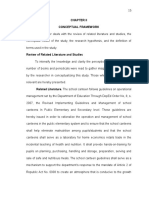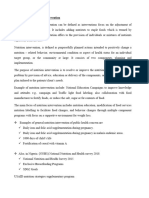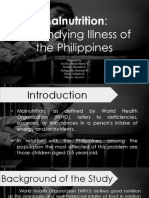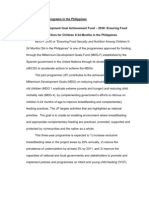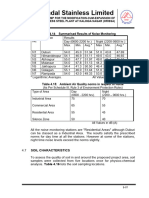Management of Childhood Illnesses
Management of Childhood Illnesses
Uploaded by
Analiza GayoCopyright:
Available Formats
Management of Childhood Illnesses
Management of Childhood Illnesses
Uploaded by
Analiza GayoOriginal Description:
Original Title
Copyright
Available Formats
Share this document
Did you find this document useful?
Is this content inappropriate?
Copyright:
Available Formats
Management of Childhood Illnesses
Management of Childhood Illnesses
Uploaded by
Analiza GayoCopyright:
Available Formats
MANAGEMENT OF CHILDHOOD ILLNESSES
Methods in Managing Childhood Illnesses
Children with various health conditions although considered common diseases
are difficult to manage. Some diseases have the same symptoms that need
further assessment before classification and treatment takes place. There are
several methods utilized in managing childhood illnesses. These are:
• Assess the patient
Taking the history of the patient is one disease condition. This can be done
by asking and observing the patient’s condition to explore the possible causes.
Classify the disease
A thorough assessment supported with laboratory results in classification of
illnesses and confirmation of the disease are :1) mild, 2)moderate, 3.)
Severe
Treat the patient
Treatment is a curative method of treating diseases. This vary on the
condition of the patient
Counsel the patient
Providing health education to clients promotes health and avoid risk of
infection. These are important for parents/caregivers especially who lack
knowledge on health practices and risks factors that contribute to disease
ailments.
Nutritional Program:
The Goal of the nutrition program is to improve quality of life of Filipinos through
better nutrition, improved health and increased productivity.
Objectives :
Reduction in the proportion of Filipinos household with intake below 100% of the
dietary energy requirement from 53.2% to 44.0%.
I will also give you 5 out of 9 Reductions said in the objectives:
a. Underweight among pre school children
b. Chronic energy deficiency among pregnant women
c. Non communicable disease
d. Reduction in prevalence of iron deficiency disorder among lactating
mothers
e. Reduction in the prevalence of low birth weight
Programs and Projects:
1.) Micronutrient Supplementation
is one of the interventions to address the health and nutritional needs of
infants and children and improve their growth and survival. Araw ng Sangkap
Pinoy (ASAP) known as Garantisadong Pambata and Child Health Week is
the approach adopted to provide micronutrient supplements to 6-71 months
old. Some examples of Micronutrients are the Iron, Vitamins, Minerals and
many more.
2.) Food Fortification
is also pushed to improve nutritional status of the populace to include the
children. The food fortification Act of 2000 provides the mandatory
fortification of staples namely flour, with iron and Vitamin A, cooking oil and
refined sugar with Vitamin A and rice with Iron and the voluntary fortification
of processed foods through the “Sangkap Pinoy Seal”
3.) Essential Maternal and Child Health Service Package
This ensures the right of the child to survival, development, protection, and
participation. It includes the delivery of essential maternal and child health
and nutrition package of services that will ensure the right of survival,
development, protection, and participation as follows:
Breast Feeding, Complimentary feeding, Micro nutrient Supplementation
4.) Nutrition information, communication and Education
These includes the promotion to nutritional guidelines for Filipinos and other
nutrition key messages and training of health workers.
5.) Home, School and Community Food Production
It includes establishments of kitchens, gardens in homes, schools and in
communities in Urban and Rural areas to serve as source of additional food
for home and establishment demonstration centers and nurseries and
distribution of planting materials.
6.) Food Assistance
Includes center based complementary feeding for wasted/stunted children
children and pregnant women with delivering low birth weight . This maybe
done in school. Rice distribution is done in school through the efforts of local
units. Food discounts were provided through Tindahan Natin Program.
7.) Livelihood Assistance
Is done by provision of credit and livelihood opportunities to poor households
especially those with malnourished children through linkage with lending and
financial institutions. Functional literacy training helps in this endeavor
(COMMUNITY HEALTH NURSING theory)
Section 2
Submitted By:
Gayo, Analiza B.
Irasubije, Sandrine
Ollabis, Hana
Submitted To:
Maam: Midang
You might also like
- Emily Ness - The Testosterone ChefDocument210 pagesEmily Ness - The Testosterone ChefJake Masters100% (3)
- Project Proposal On Child Nutrition For Sustainable Health and Prenatal ClinicDocument6 pagesProject Proposal On Child Nutrition For Sustainable Health and Prenatal Clinicczeremar chan100% (4)
- MODULE IV. Notes 1Document10 pagesMODULE IV. Notes 1Thea Shaine B. SILARDE100% (1)
- Project Proposal On Child Nutrition For Sustainable Health and Prenatal ClinicDocument5 pagesProject Proposal On Child Nutrition For Sustainable Health and Prenatal Clinicczeremar chan0% (1)
- Nutrition Month PPT As of 16 June 2021Document36 pagesNutrition Month PPT As of 16 June 2021BARANGAY TUNASANNo ratings yet
- Botswana NnyepiDocument19 pagesBotswana NnyepiBang BojesNo ratings yet
- Nutriton ProgramDocument2 pagesNutriton ProgramAngel BunolNo ratings yet
- Competency Appraisal On Community Health NursingDocument5 pagesCompetency Appraisal On Community Health NursingLea TanNo ratings yet
- Nutritional Interventions: Meseret Moroda (MPH in Nutrition) Salale University October, 2023Document48 pagesNutritional Interventions: Meseret Moroda (MPH in Nutrition) Salale University October, 2023Edo JeldeNo ratings yet
- Kurukshetra August 2023 f0f9b350d6Document17 pagesKurukshetra August 2023 f0f9b350d6mydogpilluNo ratings yet
- PHN The Phil - Nut.progDocument21 pagesPHN The Phil - Nut.progDaniela Kate Separez SimbajonNo ratings yet
- Childhood Malnutrition in Developing CountriesDocument34 pagesChildhood Malnutrition in Developing CountriesJoanne MayNo ratings yet
- Session 4Document30 pagesSession 4Binu MongarNo ratings yet
- Community Nutrition PlanDocument14 pagesCommunity Nutrition Planapi-703153445No ratings yet
- Nutrition Month PPT As of 16 June 2021Document32 pagesNutrition Month PPT As of 16 June 2021Christy ParinasanNo ratings yet
- #Community NutritionDocument23 pages#Community Nutritionأحمد سعيد النكلاويNo ratings yet
- Tlisk - Ci-Viii-D - RND - Group-D - Nutrition Problems and Programs in IndiaDocument8 pagesTlisk - Ci-Viii-D - RND - Group-D - Nutrition Problems and Programs in IndiaHorse ridersNo ratings yet
- Nutritional Status and Feeding Practices of Students Within The Age of 5-12 Years in Masaba Primary School BidaDocument29 pagesNutritional Status and Feeding Practices of Students Within The Age of 5-12 Years in Masaba Primary School Bidaadeoye abassNo ratings yet
- Community Nutrition PlanDocument14 pagesCommunity Nutrition Planapi-704100991No ratings yet
- Micronutrient Supplementation ProgramDocument5 pagesMicronutrient Supplementation Programthenabear.hNo ratings yet
- Bioethics New Ass 1111Document21 pagesBioethics New Ass 1111Joanne Bernadette AguilarNo ratings yet
- Northern University Assignment DemoDocument5 pagesNorthern University Assignment Demoasiansadia6No ratings yet
- Jonalyn Chapter 2 Edited 2 22Document34 pagesJonalyn Chapter 2 Edited 2 22evangeline san jose100% (1)
- Community Nutrition Programs in IndiaDocument10 pagesCommunity Nutrition Programs in Indiayusrah shabbirNo ratings yet
- Chapter One - ThreeDocument26 pagesChapter One - ThreeSamson ikenna OkonkwoNo ratings yet
- Public Health Nutrition InterventionDocument9 pagesPublic Health Nutrition Interventionpdsth7mtsjNo ratings yet
- Malnutrition:: The Undying Illness of The PhilippinesDocument15 pagesMalnutrition:: The Undying Illness of The PhilippinesMaria NathaliaNo ratings yet
- REPORT - Nutrition Intervention Programs in The PhilippinesDocument9 pagesREPORT - Nutrition Intervention Programs in The PhilippinesJennifer Manic ZaideNo ratings yet
- Icds, School NutritionDocument6 pagesIcds, School NutritionSrishti BajajNo ratings yet
- Creating Mass Movement To Address MalnutritionDocument17 pagesCreating Mass Movement To Address MalnutritionCHAITI CHAKRABORTYNo ratings yet
- Eden Institute Department of Clinical Medicine: Lecture Notes: The First 1000 MCDPDocument9 pagesEden Institute Department of Clinical Medicine: Lecture Notes: The First 1000 MCDPChris Gift AkufunaNo ratings yet
- Obg-Assignment On Family Welfare ServicesDocument20 pagesObg-Assignment On Family Welfare ServicesRashmi C S80% (10)
- A Disseration Submitted As A Partial Fulfilment For Award of The Diploma in Community Nutrition.Document8 pagesA Disseration Submitted As A Partial Fulfilment For Award of The Diploma in Community Nutrition.Prince HakimNo ratings yet
- Invertir en Los Primeros Años Durante COVID-19 - World - BankDocument4 pagesInvertir en Los Primeros Años Durante COVID-19 - World - BankFrancisco Alejandro Riveros RamírezNo ratings yet
- Health Problem Family Nursing Problems Goal of Care Objectives of Care Interventions Measures Methos of Nurse-Family Contact Resources RequiredDocument2 pagesHealth Problem Family Nursing Problems Goal of Care Objectives of Care Interventions Measures Methos of Nurse-Family Contact Resources Requiredzharell1019No ratings yet
- NutritionSensitive LAWDocument49 pagesNutritionSensitive LAWSiti Ika FitrasyahNo ratings yet
- Bibliography Palad, J - Pico PDFDocument8 pagesBibliography Palad, J - Pico PDFnicole ashley picoNo ratings yet
- Unit 1Document73 pagesUnit 1Muskaan DeepNo ratings yet
- Programmes Related To Child Health and WelfareDocument40 pagesProgrammes Related To Child Health and WelfareAleena ShibuNo ratings yet
- Integrated Child Development Services (ICDS) Scheme: A Program For Holistic Development of Children in IndiaDocument5 pagesIntegrated Child Development Services (ICDS) Scheme: A Program For Holistic Development of Children in IndiaKrritika R PatelNo ratings yet
- Gideon HenryDocument48 pagesGideon HenrydavidbvrengkatNo ratings yet
- Health Care Programs - DOHDocument46 pagesHealth Care Programs - DOHZarlyn MirafloresNo ratings yet
- Public Health NutritionDocument14 pagesPublic Health NutritionKhushiNo ratings yet
- Community Nutrition ProgrammeDocument46 pagesCommunity Nutrition Programmeshijuvarghesepg100% (1)
- Community Nutrition Nestle Nutrition InstituteDocument4 pagesCommunity Nutrition Nestle Nutrition InstituteOsamaNo ratings yet
- Unit - XI-Role of Nurse in Nutrition ProgrammeDocument82 pagesUnit - XI-Role of Nurse in Nutrition ProgrammeEllen Angel100% (1)
- Seminar 3Document13 pagesSeminar 3deviprasadbiswal55No ratings yet
- NSTP Project ProposalDocument15 pagesNSTP Project ProposalleighNo ratings yet
- 12. National Nutritional Programs and role of nurseDocument23 pages12. National Nutritional Programs and role of nursenandanadevanand003No ratings yet
- Proposal Stunting AxelDocument10 pagesProposal Stunting AxelAxelJusufNo ratings yet
- Chapter Two Nutritional ConsulingDocument16 pagesChapter Two Nutritional ConsulingCabdullahi maxamed xussenNo ratings yet
- CHN Group 4 Reporting 1Document44 pagesCHN Group 4 Reporting 1RIK HAROLD GATPANDANNo ratings yet
- Nutrition Intervention: Kiday H. (Msc/Nutrition)Document42 pagesNutrition Intervention: Kiday H. (Msc/Nutrition)ruthNo ratings yet
- Program Kep AnemiDocument13 pagesProgram Kep Aneminova islamiyahNo ratings yet
- Compilation of Nutri Ed ProgramsDocument5 pagesCompilation of Nutri Ed ProgramsDarwell Chann RosalesNo ratings yet
- MalnutritionDocument5 pagesMalnutritionashraf.uk.360No ratings yet
- Luster 3Document37 pagesLuster 3Dr SunnyNo ratings yet
- NutritionDocument11 pagesNutritionalekya.anthanagariNo ratings yet
- Nutrition Rehabilitation Programme For Malnourished Children in Malaysia (Alan)Document27 pagesNutrition Rehabilitation Programme For Malnourished Children in Malaysia (Alan)SanJay Raj Subramaniam0% (1)
- NUTRITIONDocument15 pagesNUTRITIONmohantyashu98No ratings yet
- Nutrition Communication - Rhetoric RealityDocument12 pagesNutrition Communication - Rhetoric RealityAndré SartorelliNo ratings yet
- Orientation On DSP Tutok Kainan To Nutrition ImplementersDocument102 pagesOrientation On DSP Tutok Kainan To Nutrition ImplementersEdcel John Minglana LamanilaoNo ratings yet
- Performance Monitoring IndicatorsDocument52 pagesPerformance Monitoring IndicatorsannaNo ratings yet
- Essential Nutrition Actions in Nigeria: The Basics Ii ExperienceDocument59 pagesEssential Nutrition Actions in Nigeria: The Basics Ii ExperienceFrancis AminuNo ratings yet
- Imp of MicronutrientsDocument5 pagesImp of MicronutrientsDanish S MehtaNo ratings yet
- Meal Planning For AdolescentsDocument9 pagesMeal Planning For AdolescentsDaejah GordonNo ratings yet
- Ongoing Nutrition Programmes and ProjectsDocument10 pagesOngoing Nutrition Programmes and ProjectsAB DivillierNo ratings yet
- CHN & NCDDocument92 pagesCHN & NCDlorelie asisNo ratings yet
- Child Health and Development Strategic Plan Year 2001Document5 pagesChild Health and Development Strategic Plan Year 2001Piao Liang JingNo ratings yet
- Fertilizer and Soil Amendments HandbookDocument63 pagesFertilizer and Soil Amendments HandbookJitendra PankajNo ratings yet
- Stop Stunting: PROGRESS REPORT 2013-2015Document12 pagesStop Stunting: PROGRESS REPORT 2013-2015nwkimuin3328No ratings yet
- 5 XerophtalmiaDocument36 pages5 XerophtalmiaMarshet GeteNo ratings yet
- Production, Chemical and Sensory Evaluation of Cookies Fortified With Moringa Oleifera LeavesDocument8 pagesProduction, Chemical and Sensory Evaluation of Cookies Fortified With Moringa Oleifera Leavesayele asefaNo ratings yet
- MCN 12 72Document19 pagesMCN 12 72Irvan PutraNo ratings yet
- Kelompok 3 - StuntingDocument19 pagesKelompok 3 - StuntingMelinda Tri PutriNo ratings yet
- Animal Nutrioni PDFDocument14 pagesAnimal Nutrioni PDFNishant KhanalNo ratings yet
- Timor Leste Nutrition Profile Apr2014Document8 pagesTimor Leste Nutrition Profile Apr2014Paramita KelakanNo ratings yet
- Department of Health ProgramsDocument49 pagesDepartment of Health ProgramsKylie Golindang100% (1)
- Hs DhaliwalDocument37 pagesHs DhaliwalAmit KumarNo ratings yet
- q2 Grade 7 Health DLL Week 2Document9 pagesq2 Grade 7 Health DLL Week 2Rochelle Shane CastilloNo ratings yet
- Strategic Review of Food Security and Nutrition in Indonesia 2019-2020 UpdateDocument5 pagesStrategic Review of Food Security and Nutrition in Indonesia 2019-2020 UpdateAusi PalsuNo ratings yet
- 4jindal Kalinga Nagar - Part7Document10 pages4jindal Kalinga Nagar - Part7cet.ranchi7024No ratings yet
- Jurnal InternasionalDocument8 pagesJurnal InternasionalBrivita PopyNo ratings yet
- Isah Umar ProjectDocument51 pagesIsah Umar ProjectDanjuma JesseNo ratings yet
- Validation of Sentrong Sigla Criteria - BlankDocument26 pagesValidation of Sentrong Sigla Criteria - BlankkenvysNo ratings yet
- CSR Project On P GDocument23 pagesCSR Project On P GKaranJoharNo ratings yet
- MicronutrientDocument22 pagesMicronutrientSintayehu YeniewNo ratings yet
- Adolescent Girls Scheme WordDocument29 pagesAdolescent Girls Scheme WordmurtasNo ratings yet
- Detailed Lesson Plan in MAPEH GDocument6 pagesDetailed Lesson Plan in MAPEH GAlvior Elipane EirolNo ratings yet






















